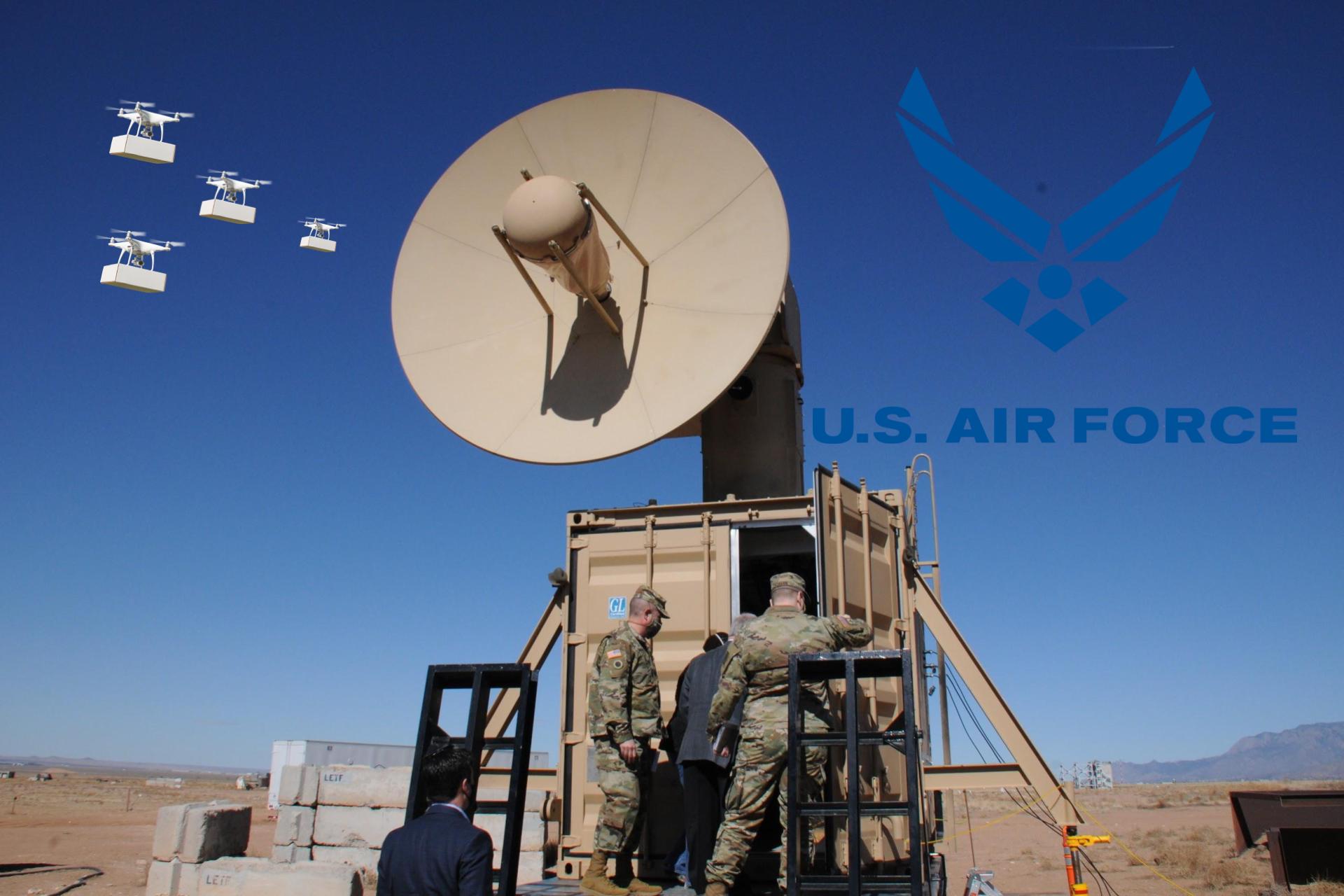HLS.Today GOV – The Air Force Research Laboratory, or AFRL, conducted a demonstration, April 5, 2023, of its high-power microwave counter drone weapon, the Tactical High-power Operational Responder, or THOR, as it engaged a swarm of multiple targets at the Chestnut Test Site, Kirtland Air Force Base.
“The THOR team flew numerous drones at the THOR system to simulate a real-world swarm attack,” said Adrian Lucero, THOR program manager at AFRL’s Directed Energy Directorate. “THOR has never been tested against these types of drones before, but this did not stop the system from dropping the targets out of the sky with its non-kinetic, speed-of-light High-Power Microwave, or HPM pulses,” he said.
Capt. Eric Plummer, a test engineer with AFRL’s Directed Energy Directorate, operated the THOR system and has been with the THOR program for nearly two years. He was responsible for aiming the THOR system at the swarm.
“THOR was exceptionally effective at disabling the swarm with its wide beam, high peak powers and fast-moving gimbal to track and disable the targets,” said Lucero.
The Tactical High-power Operational Responder, or THOR, a high-powered microwave counter drone weapon, stands ready to demonstrate its effectiveness against a swarm of multiple targets at the Air Force Research Laboratory, or AFRL, Chestnut Test Site, Kirtland Air Force Base, N.M., April 5, 2023. AFRL completed a successful demonstration of THOR simulating a real-world swarm attack. This was the first test of this scale in AFRL history.
Tactical High-power Operational Responder
The Tactical High-power Operational Responder, or THOR, a high-powered microwave counter drone weapon, stands ready to demonstrate its effectiveness against a swarm of multiple targets at the Air Force Research Laboratory, or AFRL, Chestnut Test Site, Kirtland Air Force Base, N.M., April 5, 2023. AFRL completed a successful demonstration of THOR simulating a real-world swarm attack. This was the first test of this scale in AFRL history.
As the dangers from drone swarms evolve, leaders from across the Department of Defense are working closely to ensure we are exploring different technologies like directed energy to support the needs of the warfighter in the future against such threats.
“THOR was extremely efficient with a near continuous firing of the system during the swarm engagement,” said Capt. Tylar Hanson, THOR deputy program manager. “It is an early demonstrator, and we are confident we can take this same technology and make it more effective to protect our personnel around the world.”
While AFRL celebrates the success of the demonstration, leaders at Kirtland are recognizing the hard work of their team who have decades of research in high-power electromagnetic technologies.
“We couldn’t have come this far without the perseverance and professionalism of the entire THOR team,” said Ken Miller, AFRL’s high power electromagnetics division chief. “Our scientists, Airmen and contractors worked early mornings and late nights to make this swarm demo…a great success. AFRL is committed to developing such advanced technologies to defend our service members on the front lines.
The Tactical High-power Operational Responder (THOR), a high-powered microwave counter drone weapon, stands ready to demonstrate its effectiveness against a swarm of multiple targets at the Air Force Research Laboratory, or AFRL, Chestnut Test Site, Kirtland Air Force Base, N.M., April 5, 2023. AFRL completed a successful demonstration of THOR simulating a real-world swarm attack. This was the first test of this scale in AFRL history.
The Tactical High-power Operational Responder (THOR), a high-powered microwave counter drone weapon, stands ready to demonstrate its effectiveness against a swarm of multiple targets at the Air Force Research Laboratory, or AFRL, Chestnut Test Site, Kirtland Air Force Base, N.M., April 5, 2023. AFRL completed a successful demonstration of THOR simulating a real-world swarm attack. This was the first test of this scale in AFRL history.
By the hammer of Thor! The Air Force has successfully employed its primary directed energy weapon to knock a swarm of multiple unmanned aerial vehicles out of the sky in the first test of its kind, the service announced this week.
The latest demonstration of the Air Force Research Laboratory’s Tactical High-power Operational Responder (THOR), a high-powered microwave emitter designed to take out incoming drones for short-range air base defense, took place at the Chestnut Test Site at Kirtland Air Force Base in April.
During the trial, the THOR team “flew numerous drones at the THOR system to simulate a real-world swarm attack,” said program manager Adrian Lucero in a statement. “THOR has never been tested against these types of drones before.”
THOR “was exceptionally effective at disabling the swarm with its wide beam, high peak powers, and fast-moving gimbal to track and disable the targets,” Lucero said.
First delivered to the Air Force in April 2020 and field tested “in a real-world setting” in Africa later that year, THOR consists of a 20-foot transport container that easily fits inside a C-130 Hercules transport aircraft and can be deployed for use by a pair of airmen within three hours, according to a September report from the Congressional Research Service.
The Air Force has requested $87.148 million for high-powered microwave research related to THOR in its fiscal year 2024 budget request, according to service budget documents, up from $57.623 million the previous year. The funding increase “reflects the development and delivery of a high-priority base defense mission with joint high power microwave defense system with the military services.”
While there is no publicly-released media of the THOR in action, the Air Force released a video animation in June 2021 depicting its vision for it as a quick-and-dirty counter-drone system able to disable targets with more efficiency than traditional air base defense systems or even the high-energy lasers currently in development for other service branches.
“There are several drone negating systems available; guns, nets, and laser systems,” according to the AFRL. “THOR looks to extend the range to effect and decrease the engagement time over these other deterrent devices.
U.S. military leaders have been harping on the threat posed by adversary’s unmanned aerial vehicles for years, with former U.S. Central Command chief Marine Gen. Kenneth McKenzie Jr. calling the rise of cheap and commercially-available drones in the Middle East “the most concerning tactical development since the rise of the improvised explosive device in Iraq.”
“These systems are inexpensive, easy to modify and weaponize, and easy to proliferate,” McKenzie said during a February 2021 speech at the Middle East Institute, echoing his past comments on the matter. “They provide adversaries the operational ability to surveil and target U.S. and partner facilities while affording plausible deniability and a disproportionate return on the investment, all in our adversaries’ favor.”
Drones have proven a thorn in the U.S. military’s side since 2017 when ISIS fighters began employing them to drop mortar rounds onto Iraqi security forces during the coalition campaign to retake the city of Mosul. A few years later, in 2019, the U.S. accused Iran of using a drone swarm to disable a massive oil processing facility in Saudi Arabia.
“Although an individual low-cost drone may be powerless against a high-tech system like the F-35 stealth fighter, a swarm of such drones could potentially overwhelm high-tech systems, generating significant cost-savings and potentially rendering some current platforms obsolete,” according to a 2020 CRS analysis of artificial intelligence and its relationship to U.S. national security.
Air force Tactical High Power Operational Responder (THOR)
The Air Force Research Laboratory’s Tactical High-power Operational Responder (THOR) developed for airbase defense.
Recent years have shown the potential applications of drones in conventional warfare. In the 2020 conflict between Armenia and Azerbaijan over the Nagorno-Karabakh region, drones ”performed both reconnaissance missions to support artillery use and strike missions,” according to a Center for Strategic and International Studies analysis. “Unmanned aerial vehicle (UAV) and loitering munition attacks were able to destroy heavy ground units, including T-72 tanks and advanced S-300 air defenses.”
Indeed, that trend had continued through the Russian invasion of Ukraine, which has seen the Ukrainian military aggressively retrofit commercially-available small rotorcraft to drop explosives on Russian tanks and troop positions, part of a desperate bid to supplement its existing fleet of military-grade unmanned aerial vehicles, according to recent reporting from Reuters.
It’s unclear when the Air Force might officially field the THOR for operational use in a combat zone, but based on the past comments from military leaders and the funding increase in the service’s fiscal year 2024 budget request.
“THOR was extremely efficient with a near continuous firing of the system during the swarm engagement,” said Capt. Tylar Hanson, THOR deputy program manager, in a statement regarding the April test. “It is an early demonstrator, and we are confident we can take this same technology and make it more effective to protect our personnel around the world.”
HL.Today Source: MIL.GOV








